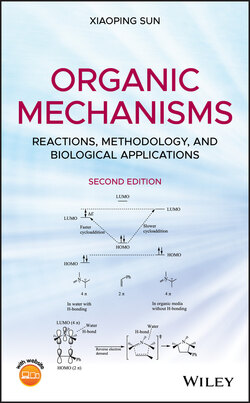Читать книгу Organic Mechanisms - Xiaoping Sun - Страница 16
1.3.2 Bimolecular Reactions
ОглавлениеFor most of concerted chemical reactions, their microscopic steps (mechanisms) involve effective collisions between two reactant molecules. Such a concerted reaction that is effected by collision of two reactant molecules to directly lead to the formation of products is defined as a bimolecular reaction. A bimolecular reaction can be effected by collision of two molecules of a same compound (Eq. 1.4) or two molecules of different compounds (Eq. 1.5).
(1.4)
(1.5)
As a result, simultaneous bond‐breaking and bond‐formation take place within the activated complex (transition state) A2* or [AB]*. This leads to spontaneous collapse of the activated complex (transition state) giving product molecules. Common examples of bimolecular reactions are thermal decomposition of hydrogen iodide (HI) to elemental iodine (I2) and hydrogen (H2) (Reaction 1.6), the SN2 reaction of hydroxide with bromomethane (Reaction 1.7), and Diels–Alder reaction of 1,3‐butadiene and ethylene (Reaction 1.8).
(1.6)
(1.7)
(1.8)
Almost all the concerted processes in organic reactions are either unimolecular or bimolecular steps.
